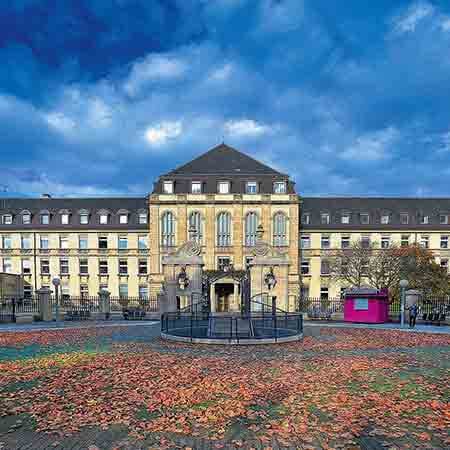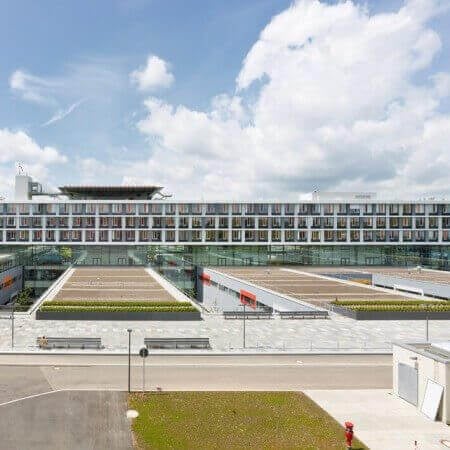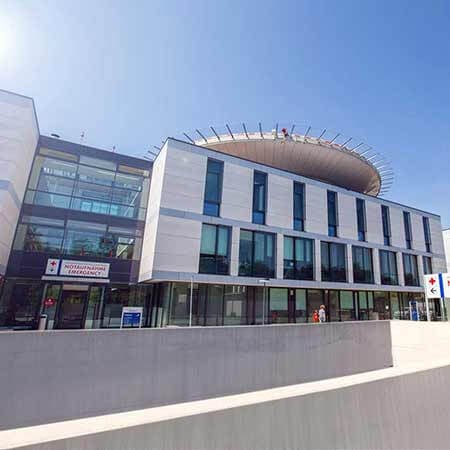Burkitt lymphoma is an aggressive non-Hodgkin's B-cell lymphoma. The disease is associated with Epstein-Barr virus, human immunodeficiency virus (HIV), and chromosomal translocations. The WHO divides Burkitt lymphoma into three clinical groups: endemic, sporadic, and immunodeficiency-associated. In developed countries, most patients can be cured of the disease. Doctors use modern chemotherapy regimens, immunotherapy, and in severe cases, a stem cell transplant may be a treatment option to choose. To get the best results with the lowest risk of complications, you can opt for undergoing your treatment abroad. You are welcome to use the Booking Health service to undergo your treatment at a specialized clinic at a favorable price.
Content
- Diagnostics
- Local treatment of early stages
- Chemotherapy
- Immunotherapy and targeted therapy
- Stem cell transplant
- Why is it better to undergo your treatment for Burkitt lymphoma abroad?
Diagnostics
The following examinations can be used for diagnosing Burkitt lymphoma:
- methods of medical imaging to assess the spread of the tumor process and to establish the stage of the disease;
- a biopsy with a histological examination of the material obtained in order to confirm the type of lymphoma.
To diagnose the early stages of the disease in adult patients, doctors use a computed tomography (CT) of the chest, abdomen, and pelvis. Children undergo a chest X-ray, ultrasound scanning of the pelvis and abdomen, as well as a CT scan of the chest, abdomen, and pelvis. Depending on the clinical picture, some patients may require a contrast-enhanced MRI of the neck and brain too. A PET/CT scan can only be conducted for a suspected recurrence or when there is resistance to therapy.
During the course of treatment, diagnostic tests are repeated several times. This is necessary for measuring the tumor foci and assessing a patient's response to treatment, as well as for an early detection of tumor recurrence.
Diagnosis confirmation methods include:
- lymph node biopsy, which aims to completely remove one of the superficially located lymph nodes for its examination;
- lumbar puncture (cerebrospinal fluid analysis), which is used to check if the tumor has spread to the central nervous system;
- bone marrow biopsy, which can confirm or exclude the spread of Burkitt lymphoma to the bone marrow.
At the time of diagnosis, the central nervous system is involved in about 15% of patients. In 30% of cases, doctors find signs of bone marrow involvement. Bone marrow lesions can sometimes dominate, and such cases of the disease are called Burkitt leukemia.
Doctors carry out the diagnostics as quickly as possible, since the timing of treatment is very important for the successful overcoming of the disease. The therapy begins within 48 hours after the establishment of a diagnosis. If you want to get medical care abroad as quickly as possible, the Booking Health service will be very helpful for you. Our specialists will help you to negotiate with the administration of the clinic to reduce the waiting period before the start of your treatment.
Local treatment of early stages
For some early-stage non-Hodgkin's lymphomas, surgery or radiation therapy is recommended alone or in combination with chemotherapy. However, in Burkitt lymphoma, this tactic is not used for the two following reasons:
- most patients respond to chemotherapy, so there is no need to remove or irradiate the tumor;
- neither surgery nor radiation therapy can allow patients to avoid subsequent chemotherapy – since the tumor is very aggressive, it can recur after its local treatment if systemic drug therapy is not additionally provided.
Therefore, radiation therapy for Burkitt lymphoma is almost never used. Surgery can sometimes be used when complications develop: for example, if a tumor in the abdominal cavity has caused a bowel obstruction.
Chemotherapy
In developed countries, 90% of children and young people are cured of sporadic Burkitt lymphoma. The treatment regimen depends on the age of the patient and the stage of the disease.
Should surgery be performed to completely remove the tumor, then it will be followed by two cycles of moderate-intensity chemotherapy. At stages 1-2 of the disease, success is achieved in 98% of cases.
Children with a residual tumor after surgery or stage 3 Burkitt lymphoma are given at least four cycles of high-intensity chemotherapy, followed by two more cycles of other drugs.
Intrathecal therapy is carried out simultaneously with systemic chemotherapy. This means that drugs are injected into the cerebrospinal fluid through a lumbar puncture.
Children with confirmed central nervous system or bone marrow involvement are given up to eight cycles of dose-dense chemotherapy, followed by two more cycles of maintenance chemotherapy. Additionally, intrathecal therapy is carried out.
In adult patients, the principles of treatment are similar, but doctors use different regimens:
- R-Hyper-CVAD;
- CODOX-M/IVAC;
- EPOCH.
In patients with recurrent Burkitt lymphoma, doctors use rescue regimens:
Highly active antiretroviral therapy has no direct antitumor effect, but is prescribed to all patients with HIV, as it allows doctors to conduct a more successful treatment of Burkitt lymphoma associated with immunodeficiency. Physicians are able to safely use high-intensity chemotherapy. Without antiretroviral therapy, less toxic chemotherapy would have to be used in this patient population, due to their lack of immune cells and susceptibility to infectious complications.
Immunotherapy and targeted therapy
Monoclonal antibodies that target CD20 antigens are an essential component of any treatment regimen in developed countries. Other drugs are used much less frequently. Some drugs are still undergoing clinical trials for Burkitt lymphoma. These include:
- CD19 and CD22 monoclonal antibodies;
- histone acetyltransferase inhibitors;
- mTOR inhibitors;
- immune checkpoint inhibitors (PD1 inhibitors);
- MYC oncogene inhibitors.
Stem cell transplant
Since most people with Burkitt lymphoma are children and young adults, many of them are candidates for stem cell transplants. The need for this procedure occurs infrequently, since the disease can usually be cured with the help of drugs. But, in some patients, the tumor does not completely disappear or it recurs after its initial treatment, forcing doctors to use more effective tools in their fight against Burkitt lymphoma.
There are two options for stem cell transplant:
An autologous transplant involves the use of the patient's own stem cells. These are harvested in advance from the patient’s blood or bone marrow and then high-dose chemotherapy is given. This can be supplemented with total body irradiation. High doses of drugs destroy all Burkitt lymphoma cells, but irreversibly suppress the bone marrow too. To restore its function, doctors inject the patient with the previously harvested stem cells. After a few weeks, the work of the hematopoietic system is restored. The therapeutic effect is provided by high doses of drugs that are used before the transplant procedure. Although Burkitt lymphoma may recur in the future, the procedure usually provides long-term remission.
An allogeneic transplant involves the transplantation of stem cells from a donor. The donor can be a brother or a sister, these relatives have a 25% probability of being a full antigen match. Stem cells from an unrelated donor can be used as well. This treatment option for Burkitt lymphoma is even more effective, but more likely to cause complications. A donor’s bone marrow may be rejected by the patient's immune system or attack the patient's own body if the antigen compatibility is incomplete. However, if the procedure is successful, the new bone marrow produces white blood cells that attack the Burkitt lymphoma cells and can completely cure the cancer. This reaction is called graft-versus-tumor.
Why is it better to undergo your treatment for Burkitt lymphoma abroad?
Burkitt lymphoma is a very aggressive and rapidly progressive tumor. It is very difficult to cure it in adults, and in patients in whom the neoplasm recurs after its initial treatment. The patient needs the help of the best doctors and the use of the latest technologies and drugs to cope with this disease.
There are several reasons for you to undergo your treatment of Burkitt lymphoma abroad:
- modern regimens of intensive chemotherapy, with an efficiency of up to 90% (in the early stages this indicator is up to 98%);
- high-quality accompanying treatment, which helps to avoid the complications associated with intensive chemotherapy;
- minimally invasive surgery for the treatment of complications of Burkitt lymphoma;
- new types of radiation therapy that destroy the tumor, hardly damaging the nearby healthy tissue;
- modern drugs for immunotherapy, which increase the effectiveness of chemotherapy;
- when standard treatment regimens are ineffective, the patient can take part in clinical trials of new drugs that have already proven themselves well in previous phases of the trials;
- even therapy-resistant and recurrent tumors can be successfully treated abroad with a stem cell transplant.
You are welcome to use the Booking Health website to find out the cost of treatment and make your appointment at a clinic. Our website presents the best cancer centers in the world. Please leave your request on our website and our specialists will help you to select a clinic and a doctor, as well as arrange your trip to a developed country. When making your treatment appointment through the Booking Health service, the cost of treatment will be lower due to the lack of additional coefficients for foreign patients.
Authors:
The article was edited by medical experts, board certified doctors Dr. Vadim Zhiliuk and Dr. Sergey Pashchenko. For the treatment of the conditions referred to in the article, you must consult a doctor; the information in the article is not intended for self-medication!
Sources:
Cancer Research Institute
American Cancer Society
Verywell Health










